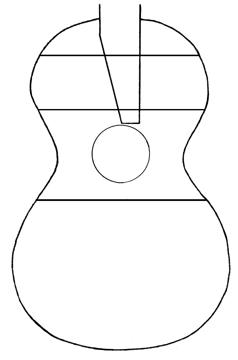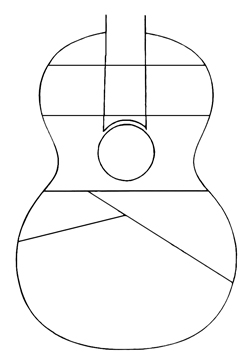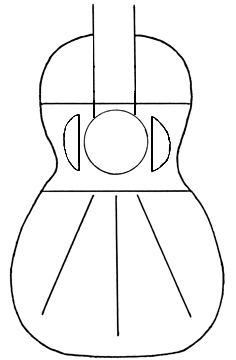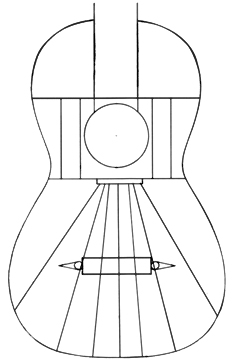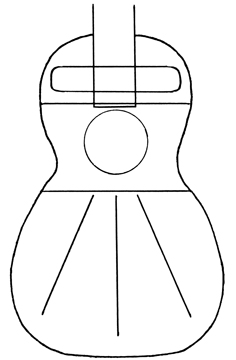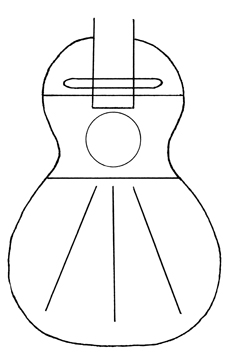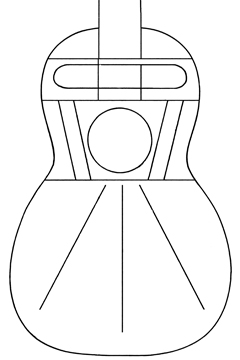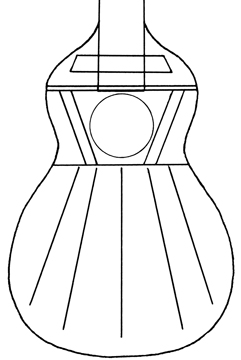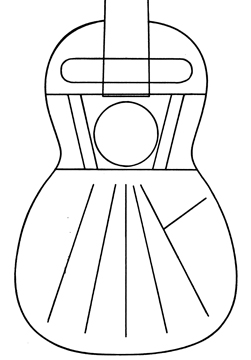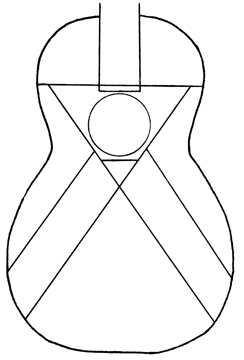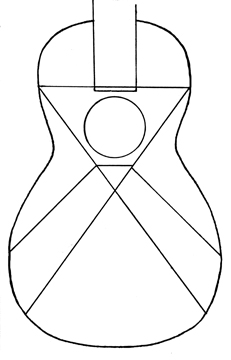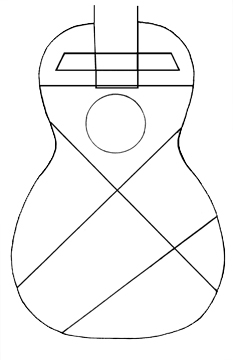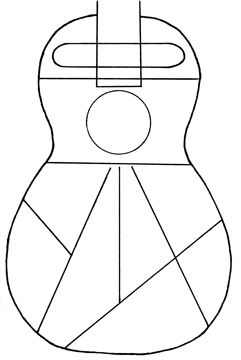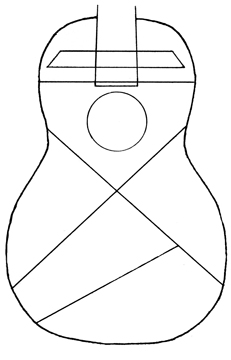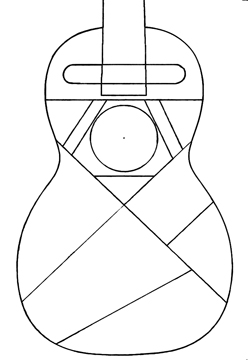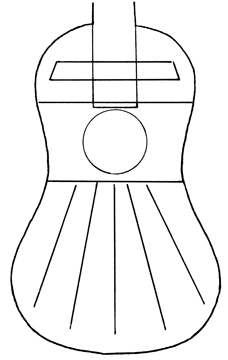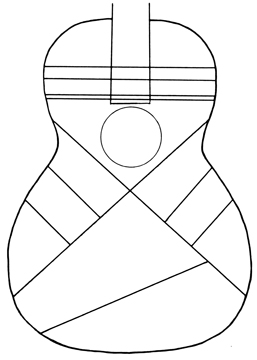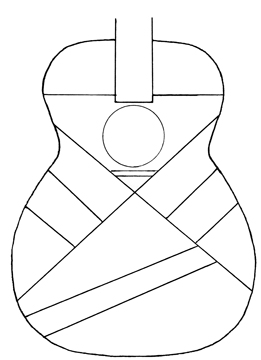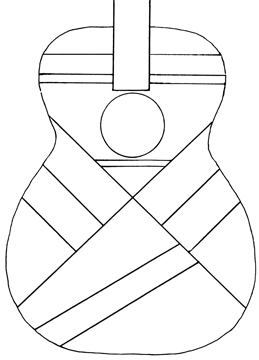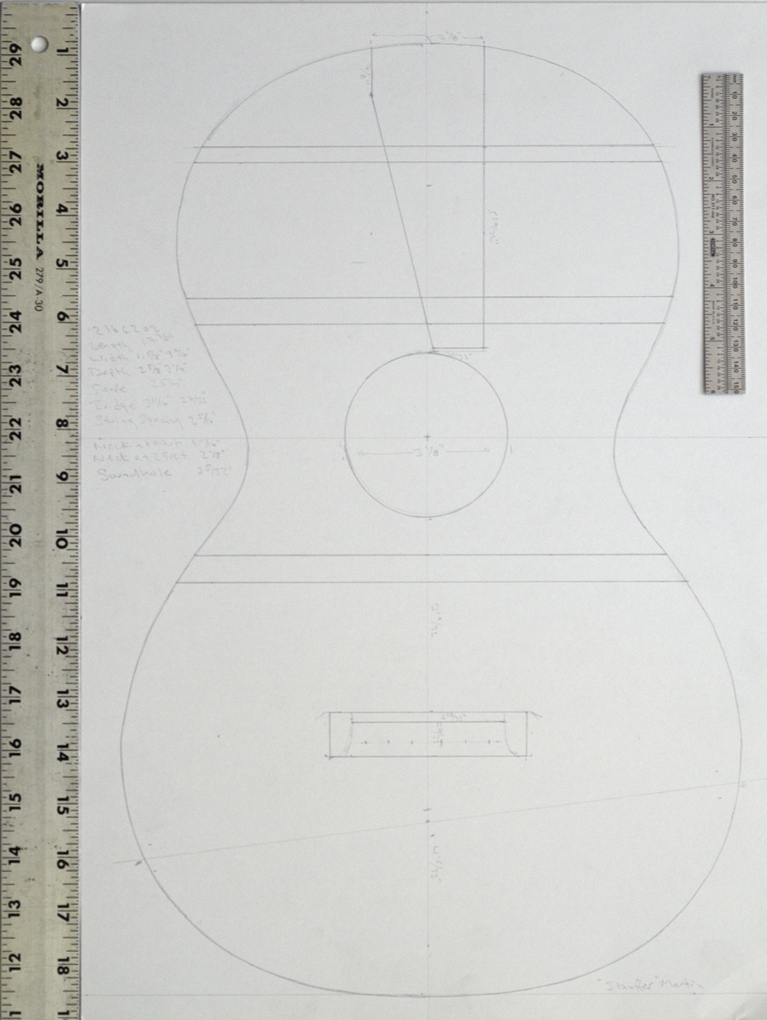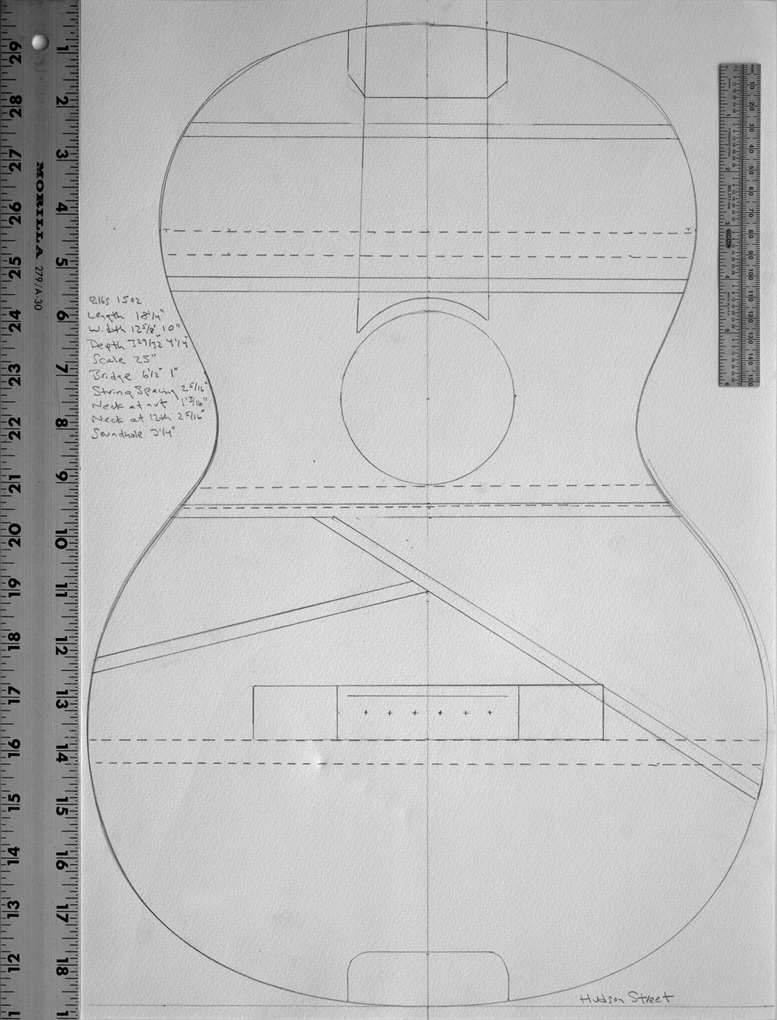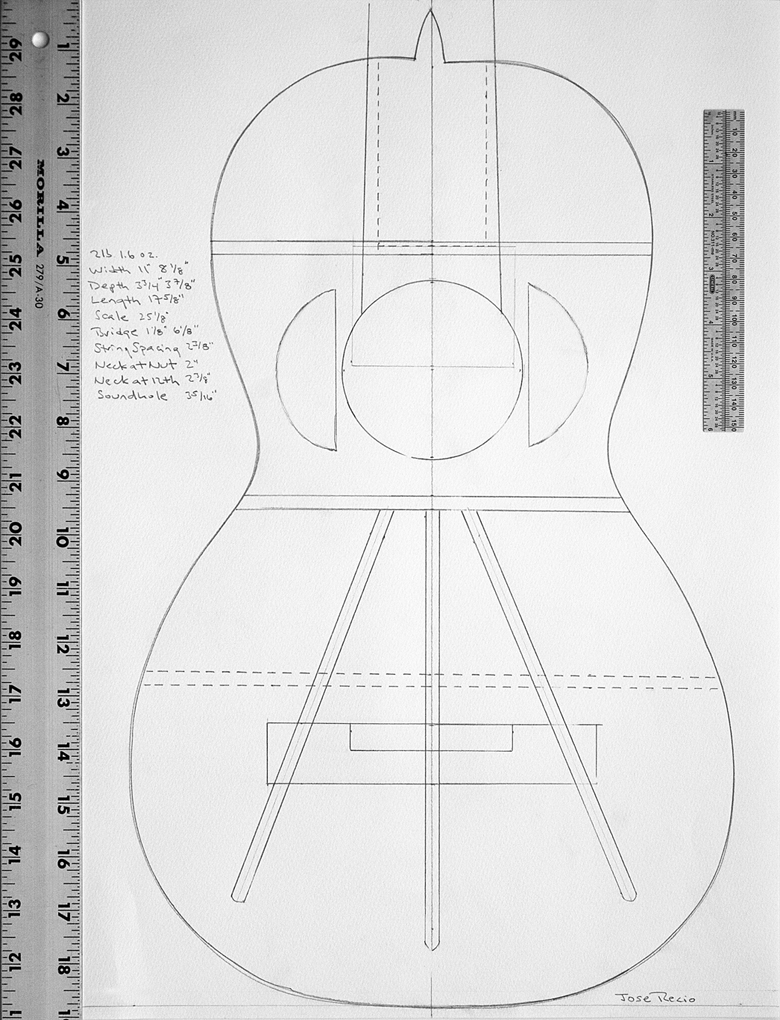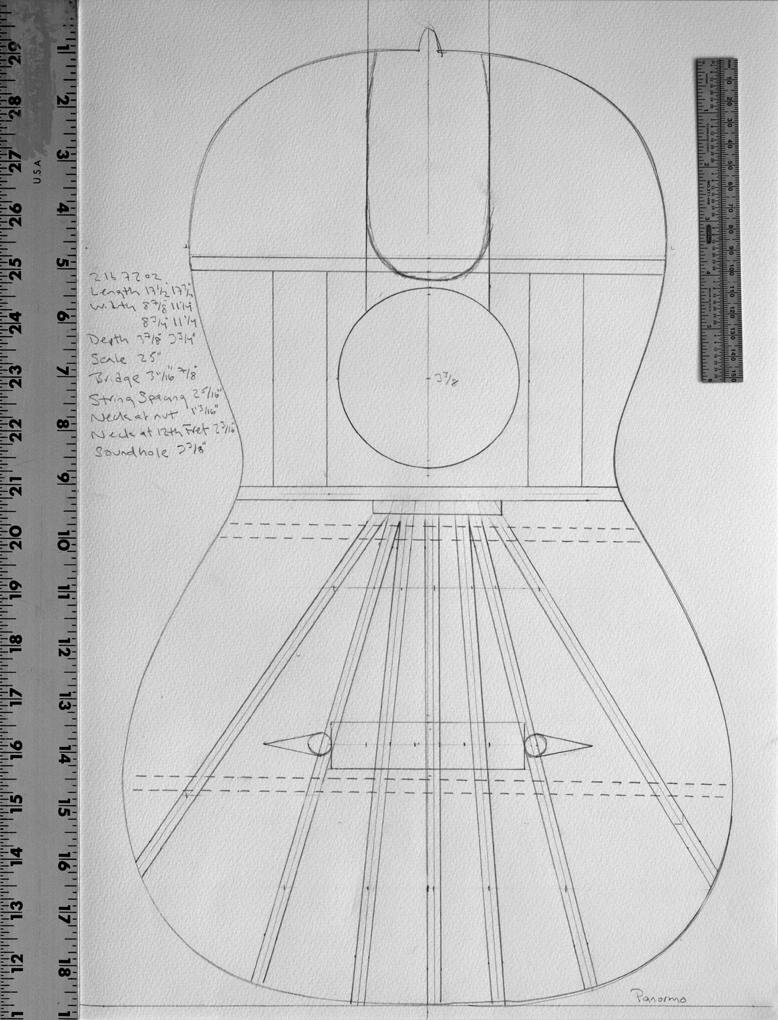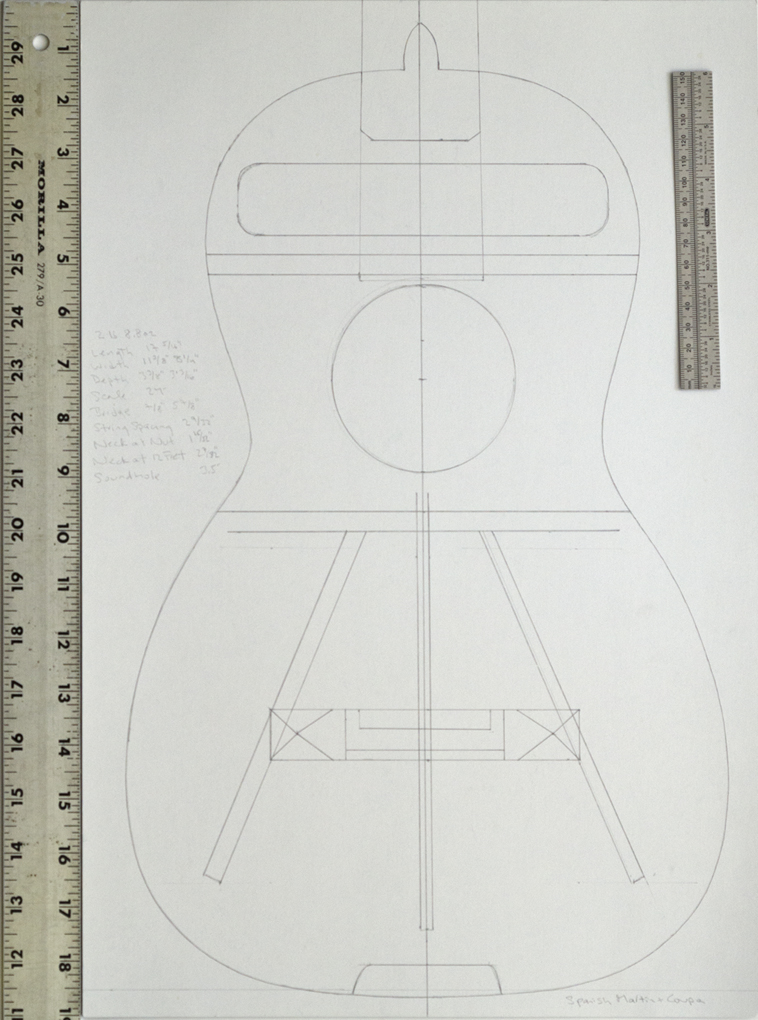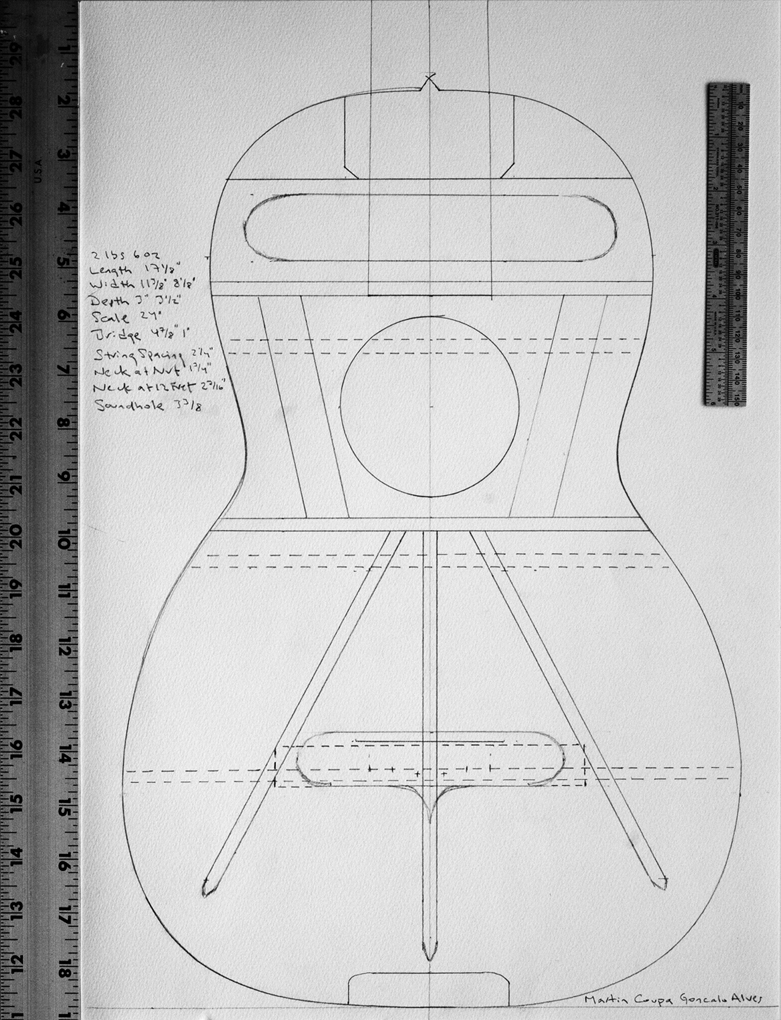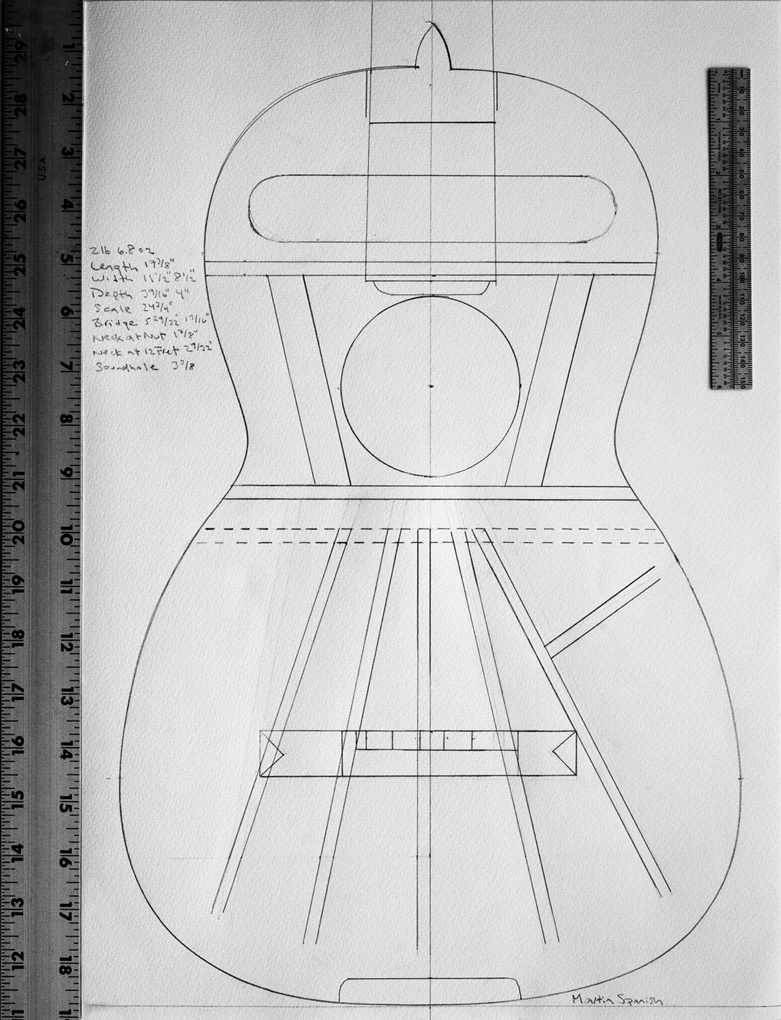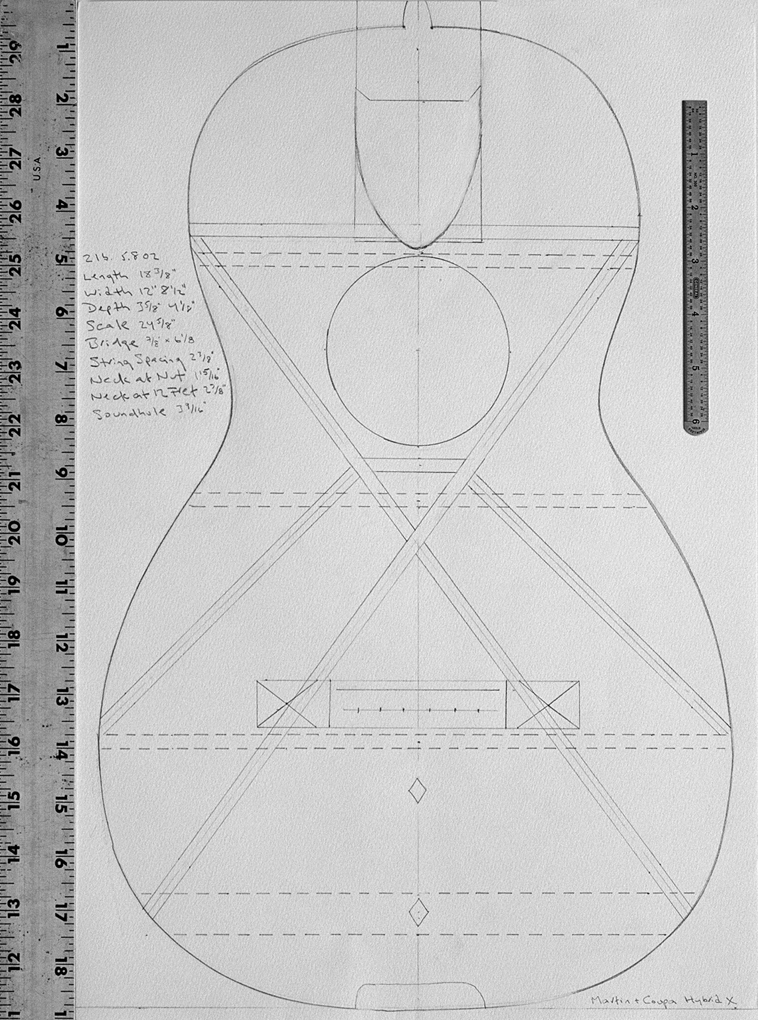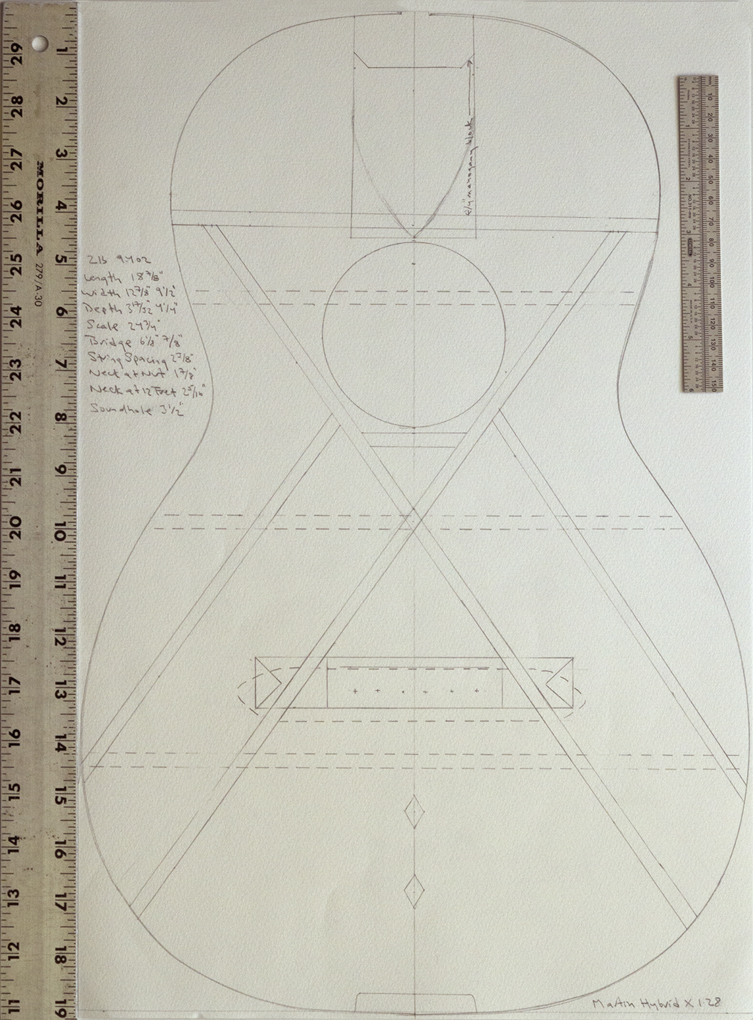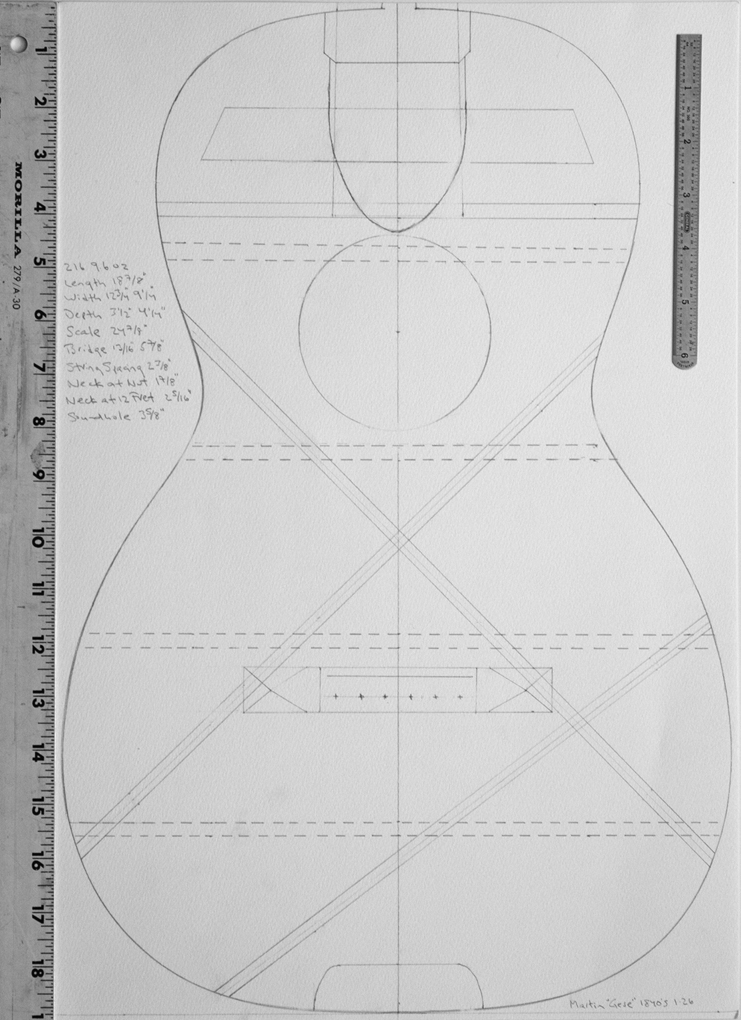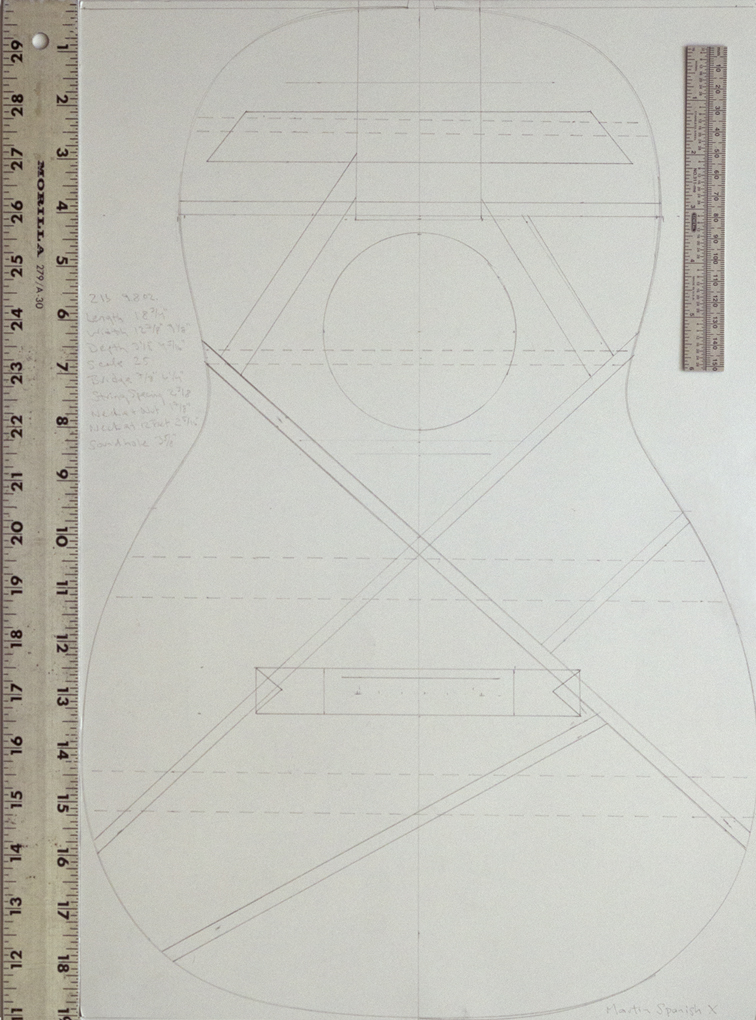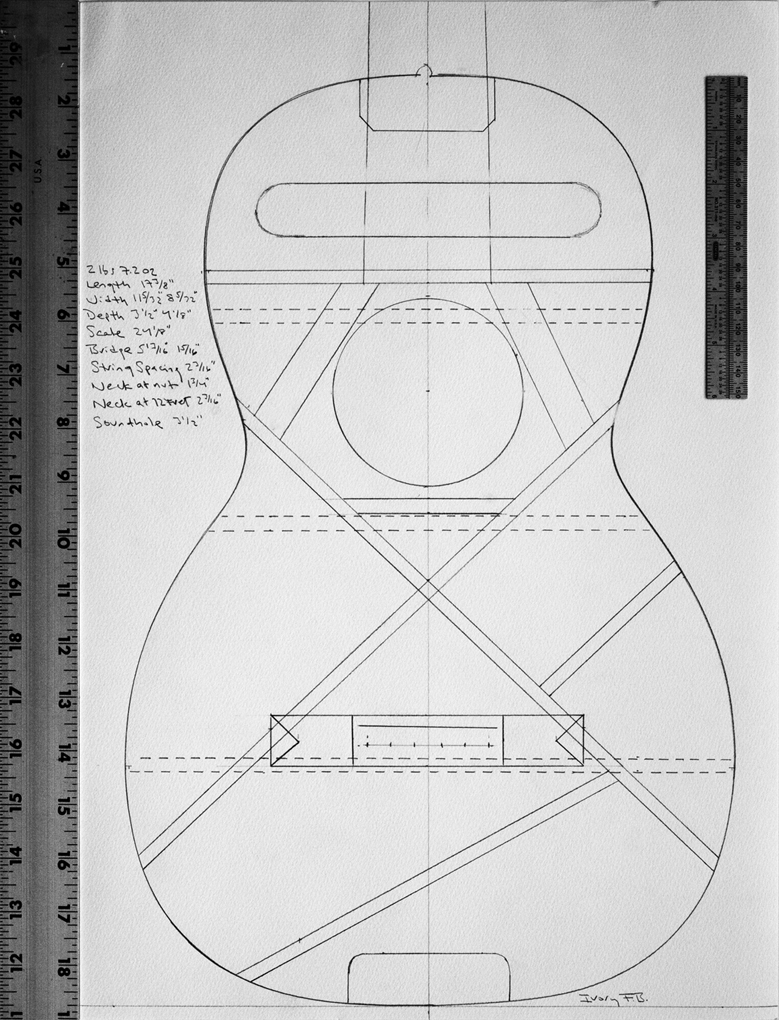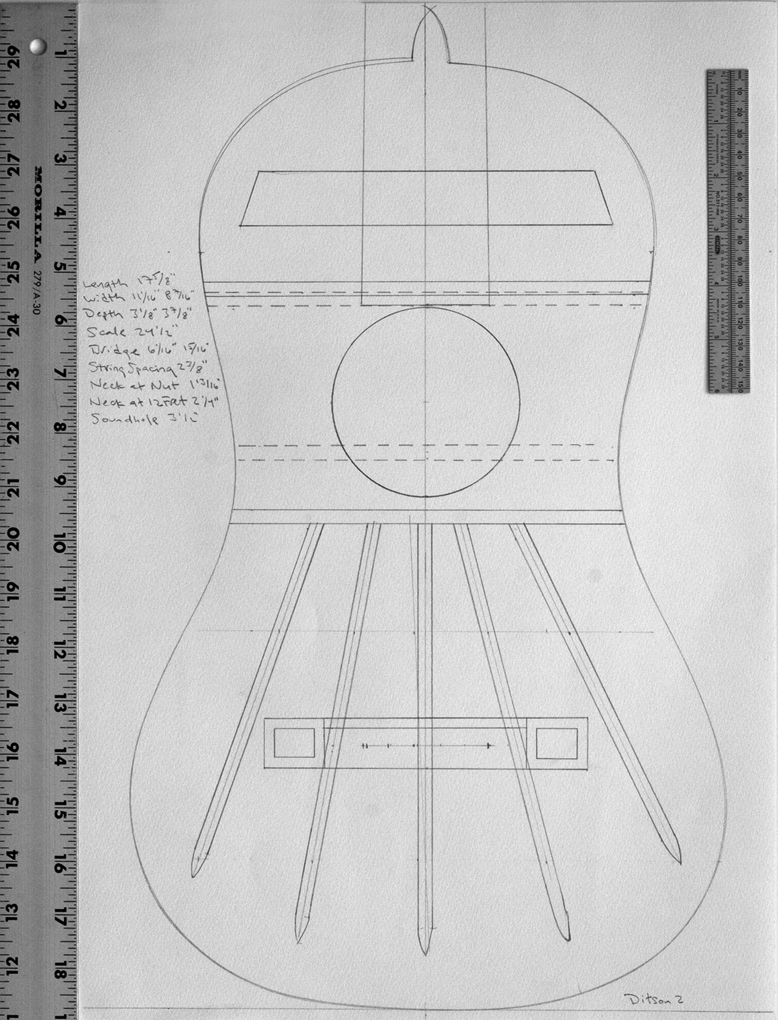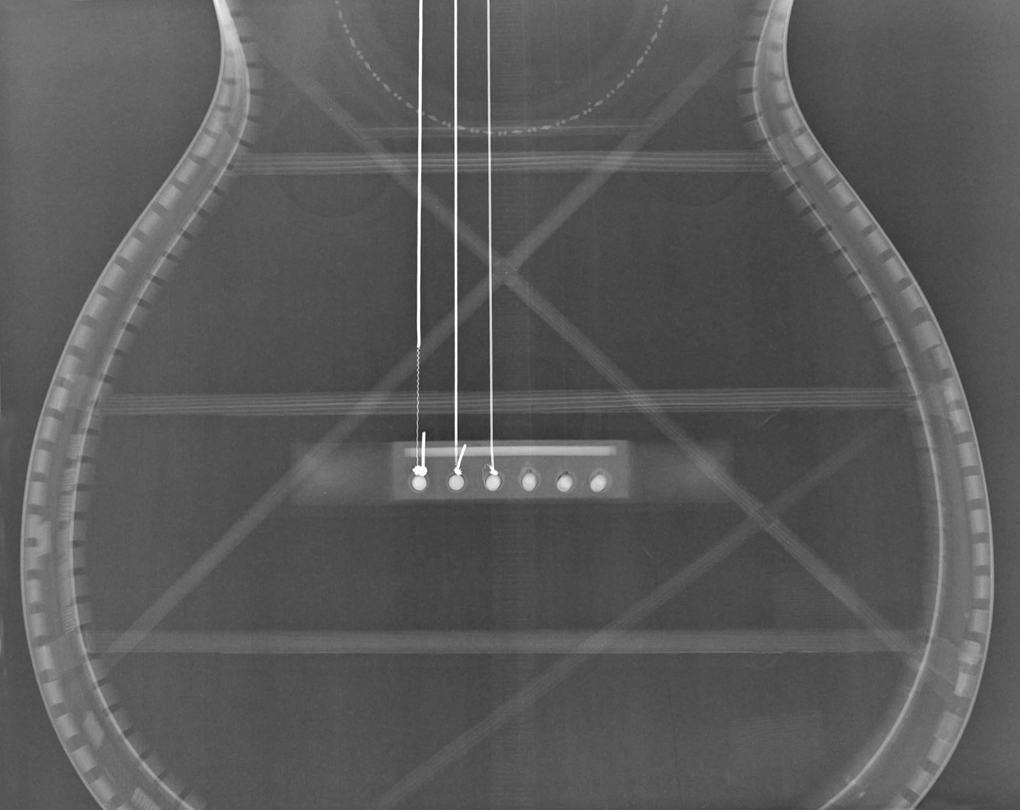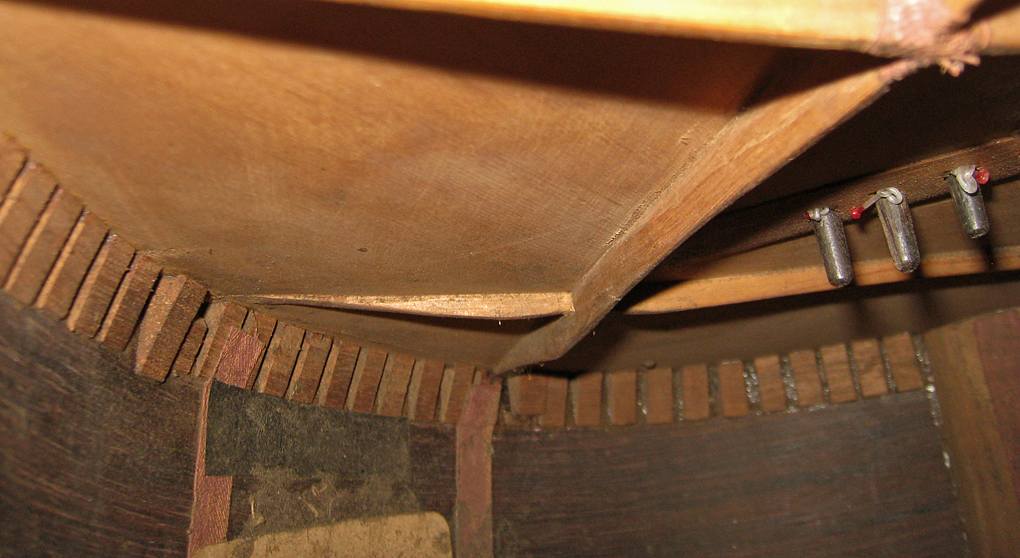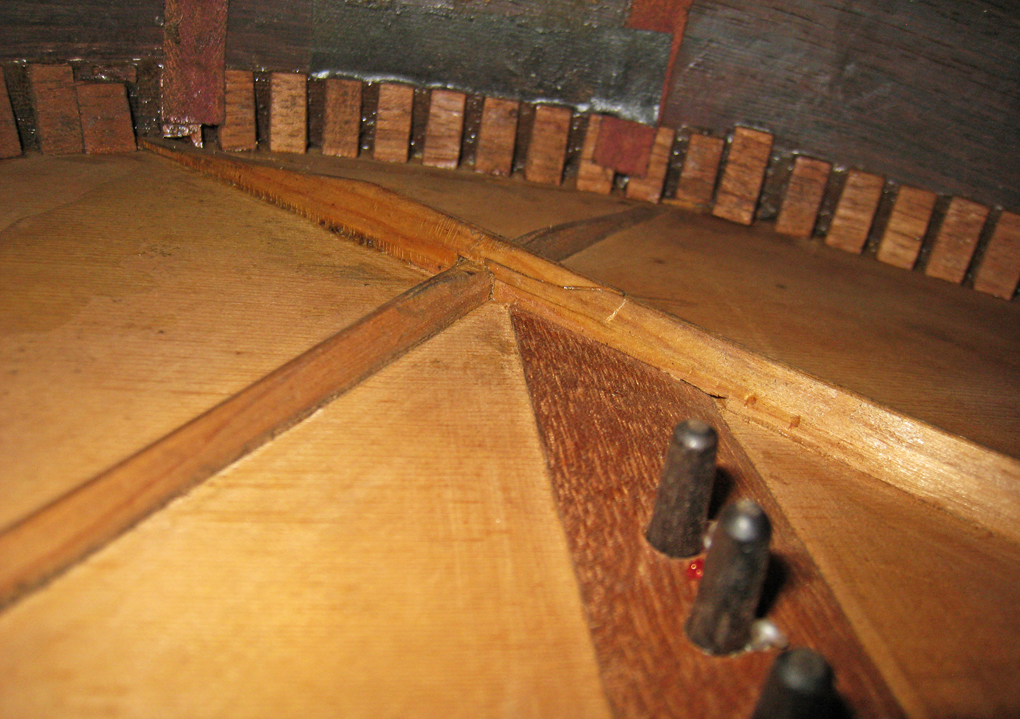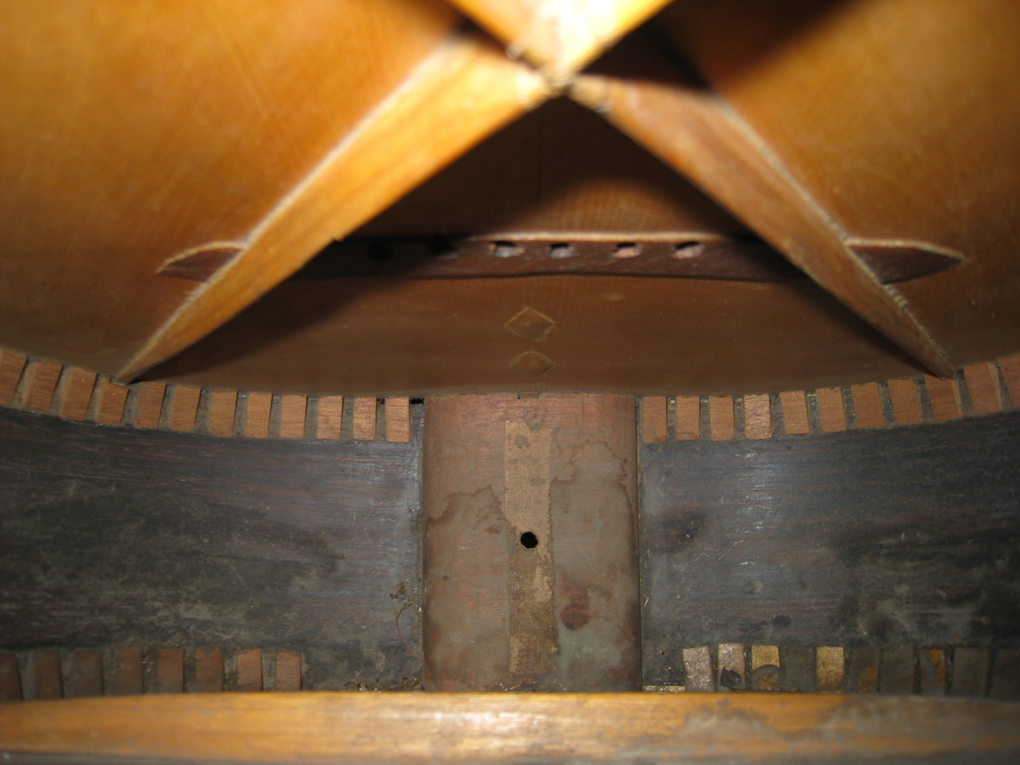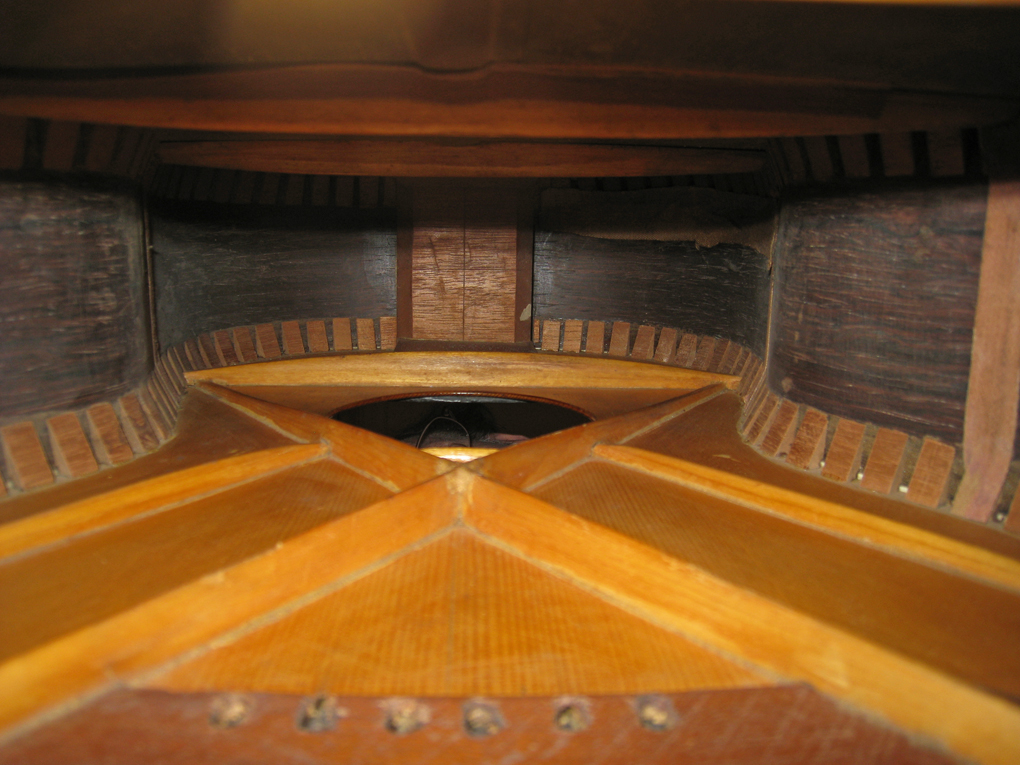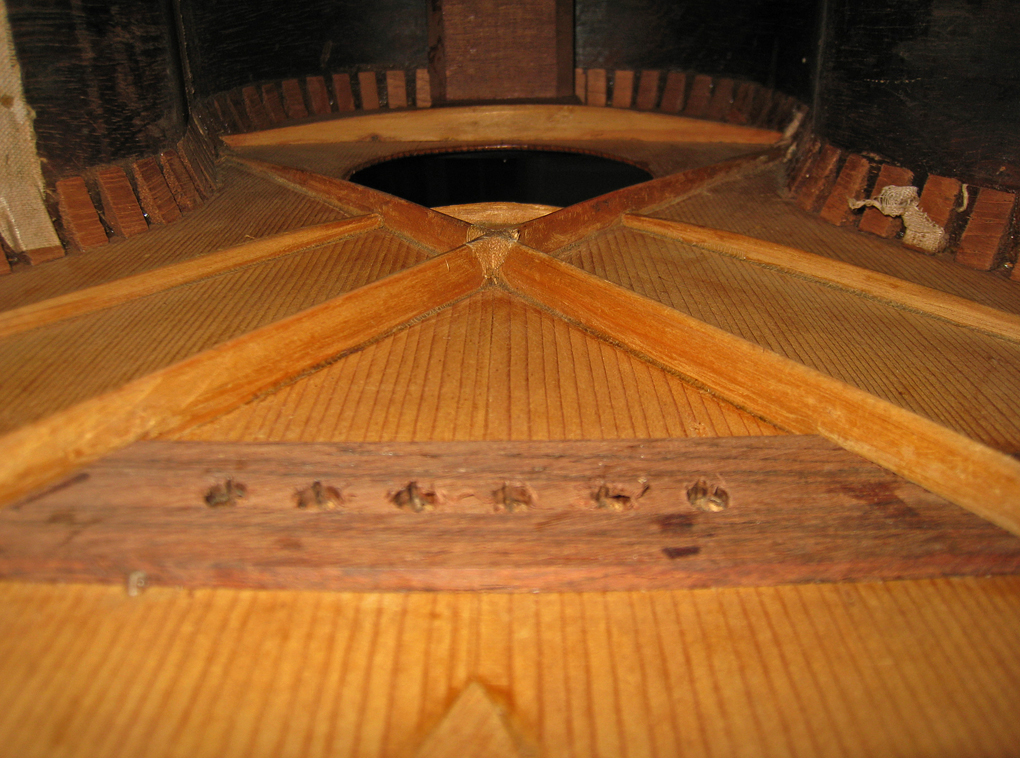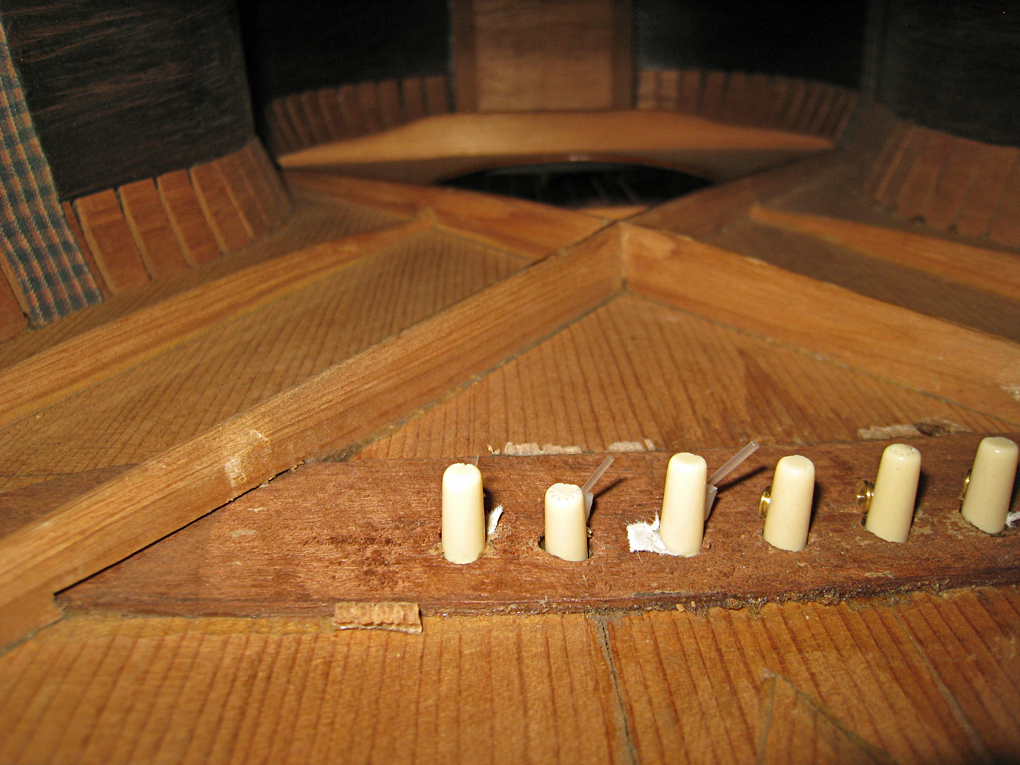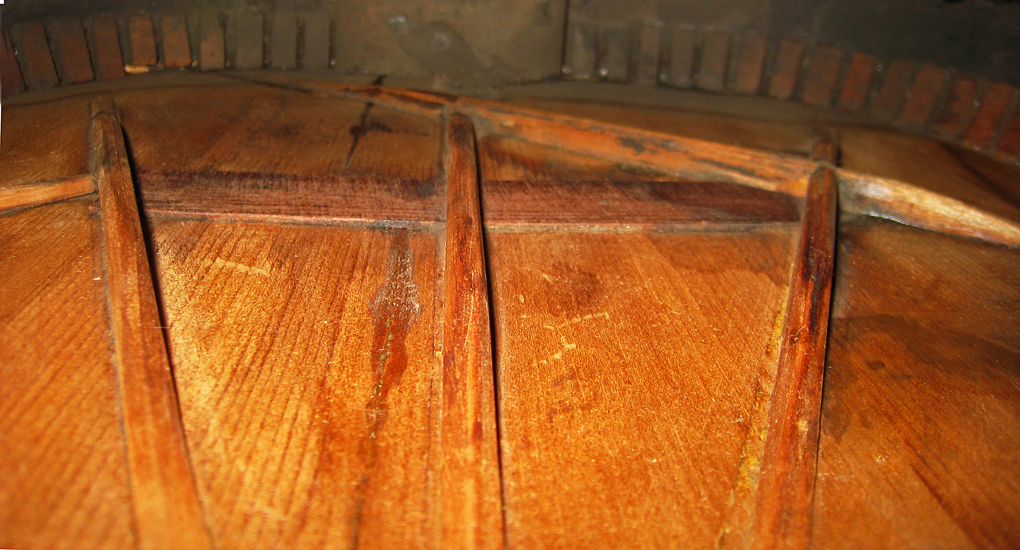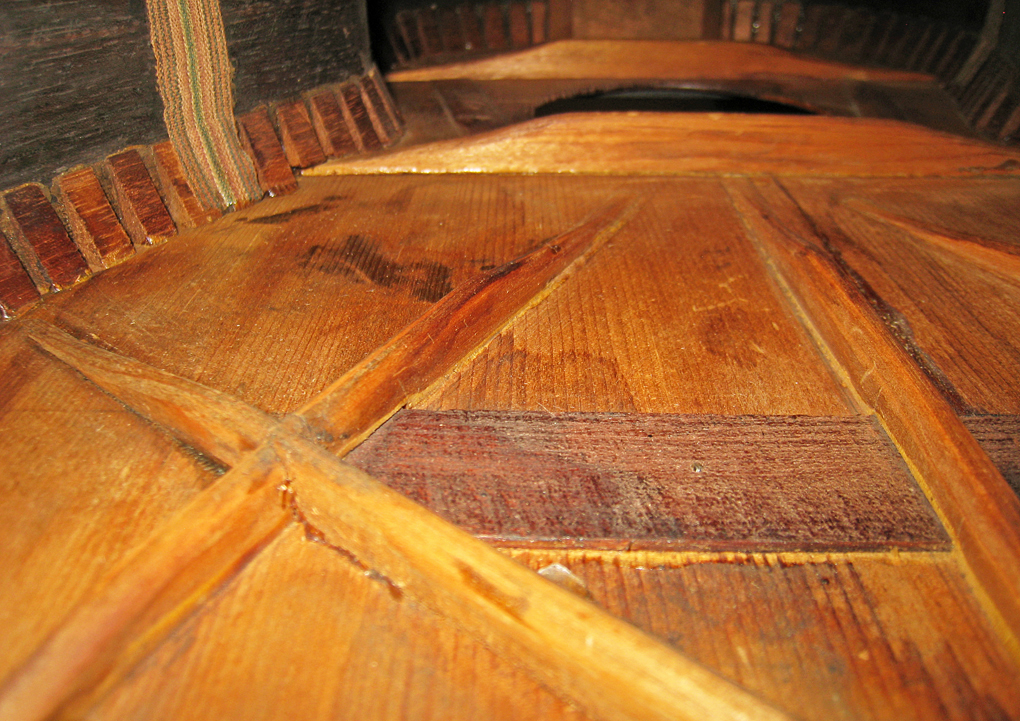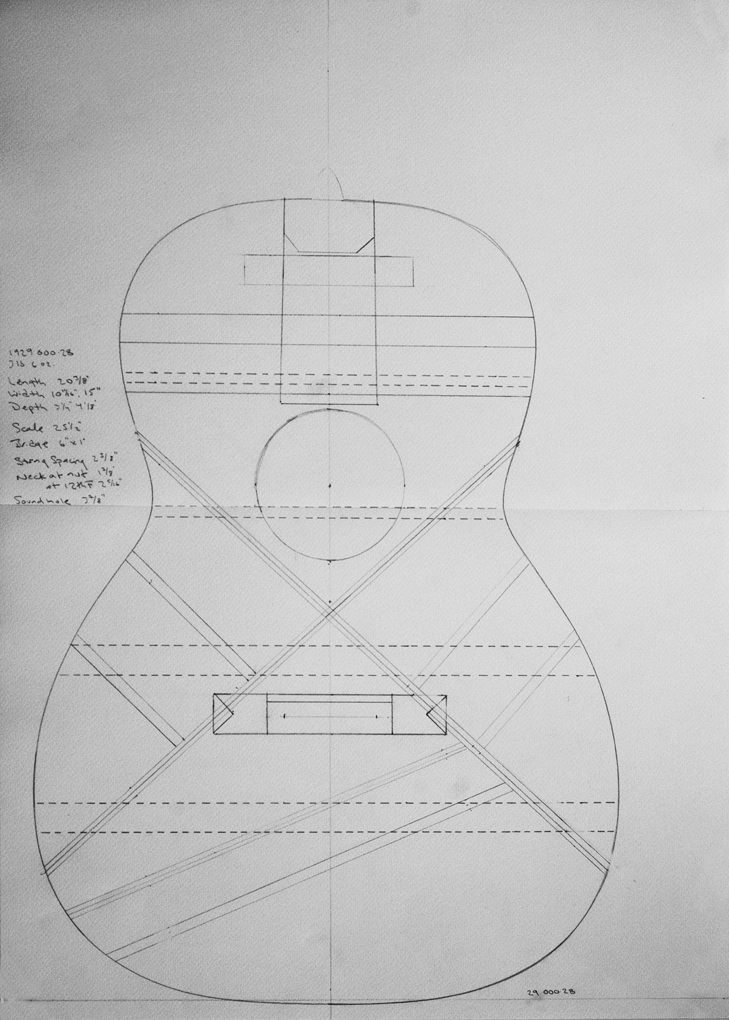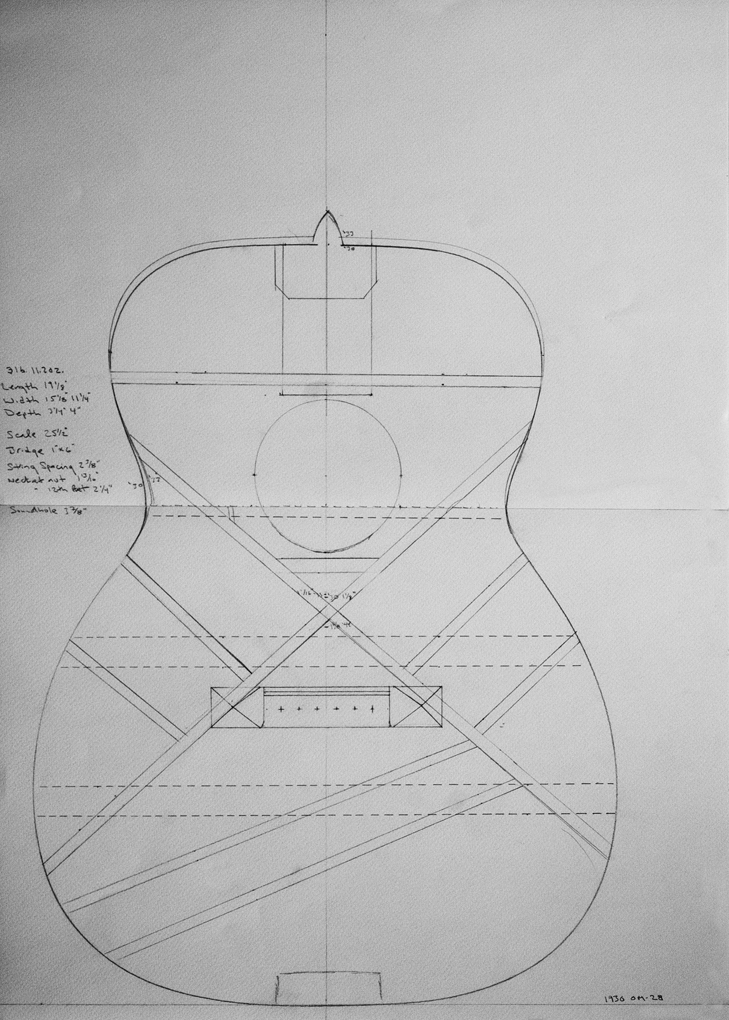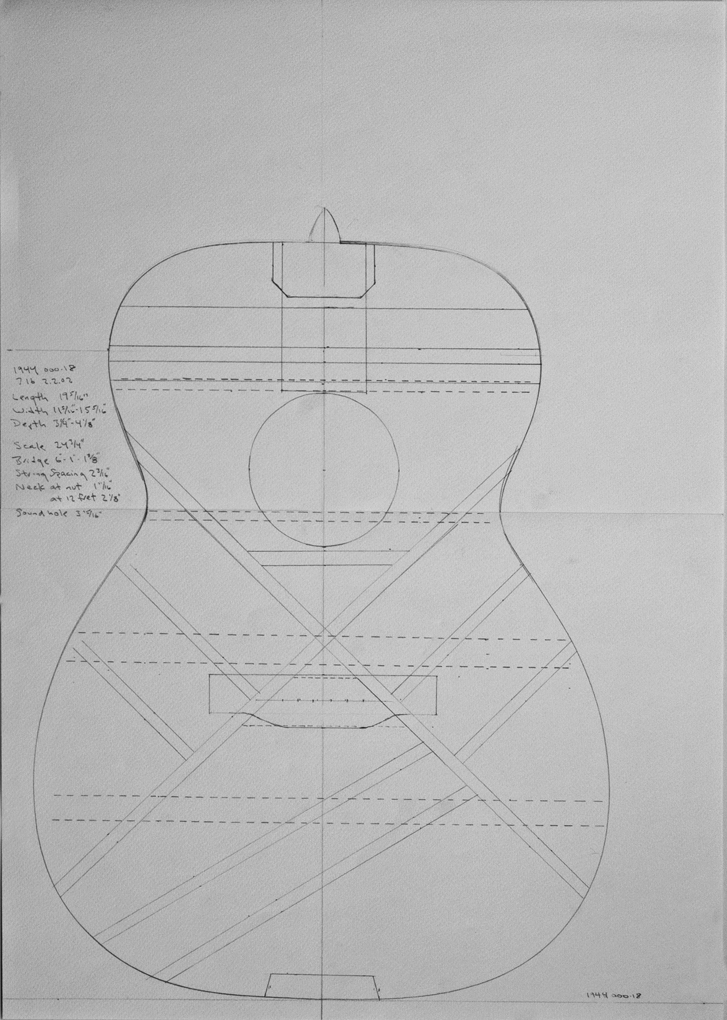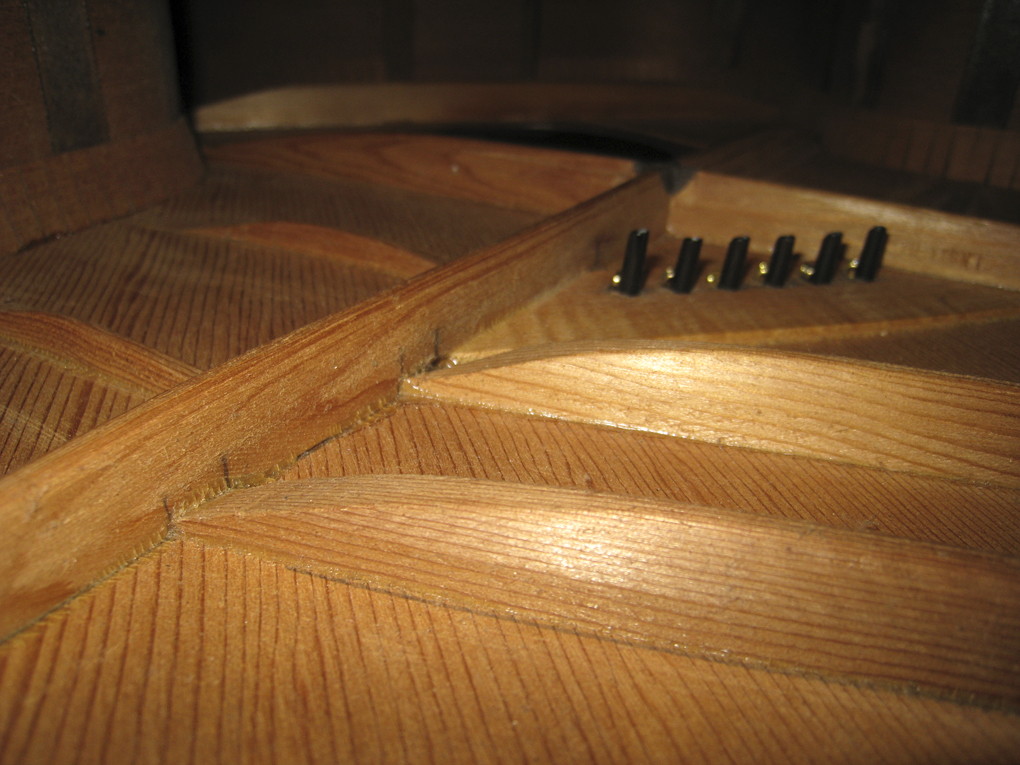"X" MARKS THE SPOT
The Development of Martin Braces
Martin braces evolved from the ladder bracing used on the Viennese guitars Martin learned to build before coming to the US, to the fan bracing learned from Spanish guitars, to several variants of X bracing before settling on the "mature" X pattern still used today.
Interestingly, both Martin and Schmidt & Maul, former Martin employees, worked in parallel, building guitars with the exact same variations. It is unknown whether the the firms collaborated or competed, or if one copied the other.
C.F. Martin built his first guitars in the 1830's with the same ladder braces seen on the guitars of his mentor, Stauffer, in the Viennese tradition.
Martin c. 1833 Stauffer
Martin c. 1837 Hudson Street
By the 1840's, Martin had discovered guitars built in the Spanish tradition, with fan braces.
Jose Recio, Cadiz
Louis 1832 Panormo Spanish Style
Martin & Coupa 1840's Spanish
Schmidt & Maul, a partnership of George Maul and Louis Schmidt, a former Martin employee, remained in New York building guitars after Martin moved to Pennsylvania. I'm beginning to think that Schmidt and Maul were Mr. Martin's bracing Gurus. By the time Martin had discovered Spanish style guitars in the early 1830's, Schmidt and Maul were also builing very similar Spanish Style guitars. It's unknown whether Martin and Schmidt & Maul were in competition or collaborating, as all of Martin's records from the period have been lost, I believe there are too many similarities to their guitars for them not to have collaborated, as photos of this early Spanish Schmidt & Maul along side the Spanish Martin & Coupa above will show.
Schmidt & Maul 1844 Spanish
Martin & Coupa Goncalo Alves Spanish
Martin continued using fan braces on many of their guitars through the end of the century, including the unique "Rennaissance" Style guitars.
Martin 1840's Renaissance
This 1840's presentation Spanish Style Martin adds a finger brace to the treble side.
Martin 1840's Spanish Presentation
Both C.F. Martin and Schmidt & Maul built guitars in the mid 1840's that experimented with different variations of bracing that led to the mature X bracing" that is standard on nearly all steel string guitars today. I've named this first form a "HybridX", as it shows elements of both fan bracing and X bracing. It essentially consists of the two outer blades of a fan brace on either side of a narrow full size X brace. This exact same configuration can be seen on guitars of this period built with the "Martin", "Martin & Coupa", and Schmidt & Maul" names.
Martin 1840's Hybrid X
Martin & Coupa 1840's Hybrid X
This first "AlternateX" Martin consists of a large X brace, with a tone bar crossing the treble side of the large X to form a smaller X on the treble side of the guitar.
Martin 1840's Alternate X
This 1847 "AlternateX" Schmidt & Maul guitar utilizes a very similar concept built on a foundation of fan bracing, with a tone bar crossing the treble blade of the fan to form a smaller X on the treble side of the guitar.
Schmidt & Maul 1847 Alternate X
This c. 1847 Martin, with most of the stylistic features of a Spanish Style guitar, but with X bracing, has been called, by at least one early Martin expert, perhaps the earliest known Martin to show the full "Mature X" essentially as it exists today.
Martin 1840's Spanish Mature X
This Martin 1850's Ivory Fingerboard Presentation maintains the tone bar and the finger brace on the treble side.
Martin 1850's Ivory Fingerboard Presentation
In 1916, Martin began building Hawaiian guitars for the Ditson Company and the Southern California Music Stores which were Martin's first cataloged Steel string guitars. Interestingly, while Martin had built X braced guitars from the late 1840's for most of their better gut string guitars, Martin chose to revert to fan bracing for their first steel strings.
Martin 1916 Ditson 2
Martin continued to build their guitars with a "Popsicle brace" for support under the fret board on all of their 12 fret guitars.
Martin 1929 000-28
The OM, the first of Martin's six string 14 fret guitars, had no "popsicle brace" forward of the sound hole. Martin soon discovered, however, that cracks developed alongside of the fretboard, and added a popsicle brace again in the early 1930's
Martin 1930 OM-28
While the 12 fret Martin has always had "forward bracing", the 14 fret became "rear braced", with the cross of the X located further back from the sound hole. Single 0 and double 0 Martins had their braces moved in 1936, while the 000 and Dreadnaught became "rear shifted" in mid 1938.
Martin 1944 000-18
Martin Bracing Diagrams
These diagrams were made through the use of exterior tracing, personal inspection, measuring with rulers, interior photographs, X-rays, "Henkograms", and illuminating the interior of the guitar so the shadows of the braces can be seen and marked.
I am in the process of measuring the shapes and dimensions of top braces, with the help of caliper, rulers, Hacklinger gauge, and X-rays, and will add cross-sectional diagrams showing the contours of the top braces soon.
Here is a diagram for the Stauffer Style Martin, the earliest known Martin c. 1833.
Martin's earliest guitars had ladder bracing.
Martin c. 1833 Stauffer Style
By 1837, the ladder bracing had been modified, with braces in the lower bout moving to a diagonal.
Martin 1837 Hudson Street Guitar
Jose Recio from Cadiz, Spain
C.F. Martin was influence by the guitars of Cadiz, Spain, borrowing the fan bracing with three blades.
It is very possible that C.F. Martin was first introduced to Spanish Style guitar after Trinidad Huerta, who was married to the daughter of Louis Panormo, the prolific luthier who built Spanish Style guitars in London, was the first classical guitarist to perform in the United States as early as 1825 as well as tour Europe extensively.
Louis Panormo 1832 Spanish Style Guitar
And here is a diagram for a very early Spanish Style Martin & Coupa, from the 1840's, with fan braces:
Martin & Coupa 1840's Spanish Style
This Spanish Schmidt & Maul from the 1840's is nearly identical to the Spanish Martin & Coupa with fan bracing.
Schmidt & Maul 1840's Spanish Style:
This 1840's Martin & Coupa made of Goncal Alves also has a simple three bladed fan.
This unusual "Renaissance" Martin from the 1840's is an early example of Martin's use of a five bladed fan.
This 1840's presentation Martin with Spanish fan bracing adds a treble side finger brace to the five blade fan.
This early Martin and Coupa shows what I call "Hybrid X" bracing, essentially an early combination of fan bracing and X bracing:
Martin & Coupa c. 1845 "Hybrid X"
This early Martin 1-28 from the mid-1840's shows the exact same "Hybrid X" bracing as the Martin & Coupa, a variation also seen in Schmidt &Maul from the period.
Martin 1-28 c. 1845 "Hybrid X"
This 1840's Martin shows another early variant of X bracing, with the tone bar extending across the X brace to form a second smaller X on the treble side.
This 1840's Schmidt & Maul has a variant of X bracing with a similar concept, with a tone bar extending across one fan of the fan bracing to form another smaller X on the treble side.
Here we see a circa 1845 Martin with mature X bracing, an exampled believed to be possibly the earliest known example.
This 1850's presentation Martin with Ivory Fingerboard maintains the tone bar and the finger brace on the treble side.
Martin returned to fan braces, oddly enough, for the first steel string guitars, Hawaiian guitars made for the Ditson and Southern California Music Stores.
On this 1840's Spanish Martin guitar the tone bar below the bridge plate extends across the treble side of the X forming a second smaller X, in a similar way as the Schmidt & Maul above has a tone bar which crosses the treble blade of the fan.
It should be noted that variations appear which are based on the fan, while other variations are based on a large X.
These are the variations of X bracing we now know of:
-the half fan/half X on the Lark St. 1845 Schmidt & Maul and on the hybrid-X Martin above.
-the fan with a tone bar below the bridge plate crossing the treble blade of the fan forming a small X on the treble side on this 1847 Schmidt & Maul.
-A large X brace with the tone bar below the bridge plate crossing the treble side of the X to form a second smaller X.
-the double X on Fred Oster's Martin illustrated in the new Longworth.
-the diamond around the bridge plate on the Martin that appeared on the Martin Guitar Forum
None of the Martins are dated, so we still don't know who did which X first.
C. F. Martin 1840's Spanish Size 1, Style 28
This Martin has what could likely be the first variation of X-bracing, which appears at about the same time on a handful of Martin, Martin & Coupa, and Schmidt & Maul Guitars, in the 1840's. Schmidt & Maul guitars with this bracing pattern have been seen dated 1845 and 1848.
Martin & Coupa Alternate X Brace Spanish Guitar
Schmidt & Maul
Schmidt and Maul were early employees of C.F. Martin in New York, and later worked upstairs in the same New York building as John Coupa, Martin's distributor at the time. Schmidt & Maul made guitars in New York which shared many design features with a Martin, after Martin moved to Cherry Hill, Pennsylvania in 1839.
1852 Schmidt & Maul
This Schmidt and Maul, dated 1847, has another early variation with a small X on the treble side formed by the transverse brace crossing the treble blade of the fan.
12 and 14 Fret Bracing Diagrams
These bracing diagrams should help to illustrate the development of the 14 fret Martin.
You can see here the difference between the 1928 and 1928 "forward shifted X-braces", and the X braces on the 1944 which have been moved further back, a change which happened in 1938 on Martin Dreadnaughts.
Click on the diagram to download a full size 1:1 diagram.
These diagrams are the property of Robert Corwin, are protected by copyright, and my not be sold. You have my permission to download these diagrams and print them for personal use.
1929 000-28
1930 OM-28
The upper outline at the top shows the shape of the upper bout on a 1933 OM-28, illustrating the smaller, rounder upper bout of the early original OM-28.
1944 000-18
Early Martin Back Braces
This chart illustrates the styles of back braces that can be seen on a number of my pre-1889 Martin guitars, and the distance between the 12th fret and the first back brace, and to each subsequent back brace.
I began to study these back braces as one more element that might give a window into how the design of Martin's guitars developed, with hopes that patterns might emerge to help us to identify the dates of early Martins, especially ones from the latter half of the 19th century which have few features to help us identify their dates of manufacture.
Studying the results, we do indeed see patterns emerging. The earliest Martins that emerge once C.F. Martin moves from the Viennese influence and toward his own Spanish influenced designs have only two small back braces. In the mid-1840's we begin to see some guitars with rather tall thin braces alone. In the 1850's we begin to see two short "V" braces combined with two half rounds. As we move further into the 1850's a pattern of two "V" shaped and two flat braces emerges as the standard. A pattern of two smaller braces and three half round braces emerges close to, if not at the time of incorporation in 1867, and dominates until the end of the century.
Back braces distance from 12th fret Back Brace type Stauffer 1830 4 4 5/8 4.5
3 wide round top Martin & Coupa 9 4
2 thin 5/8" V Martin & Coupa 4.25 4 3/8 4.5 3
2 wide 1/2" V, 1 half round, 1 6" x 3/4" flat Martin & Coupa Koa 4 5/8 3 7/8 4.5
3 wide round top Martin & Coupa Koa
Martin 1837 Hudson St 4 4.75 4.75
3 3/8" half round Martin 1840 2.5-21
Martin 1840 Spanish 3 8 3/8 4 1/8
2 thin 9/16" Martin 1845 Spanish 1 Alt X 4 3/8 3.75 3.5 3.5
Martin 1846 1 Spanish 2.25 4 3/8 3 3/8 3.75
2 thin 9/16", 2 flat Martin 3-24 4 5/8 3 7/8 4 1/2
3 1/2" V Martin 1850 1-21 zig 2 1/8 4 1/8 2 5/8 5 7/8
2 short V, 2 half round Martin 1850 1-26 zz top 2 3/8 4 3
wide 1/2" V, short V, flat Martin 1850 1-28 pearl 2 3.5 4 5
2 short V, 2 half round Martin 1850 1-28 prl zz 2.25 3 5/8 4 4.5
2 short V, 2 half round Martin 1850 1-28 Span 5 3/8 4.25 4.25
3 thin 9/16" V Martin 1850 2.5-20 2 1/8 4 3 1/4 4 3/8
2 V, 2 flat Martin 1850 2.5-24 3.75 3.5 3.5 3.5
4 thin5 /8" Martin 1850 2.5-24 Gur 3 3/8 3.5 3.5 3.5
4 thin 9/16" Martin 1850 ivory FB 4 3/8 3.75 4.5
3 1/2"
Martin 1850 Renaissance 8.5 4.5 1 3/8
2 thin 9/16", 1 1/4 short Martin 1850 2.5-27 2.5 3 7/8 4.25 4
2 V, 2 flat Martin 1855 2 - 23 lt D 2.25 4.5 4 4
2 V, 2 flat Martin 1855 2-23 dk D 2.5 4.25 4 4
2 V, 2 flat Martin 1855 2-27 1.75 4 4 4
2 V, 2 flat Martin 1860 2 1/2 20 2 1/8 3 5/8 3 3/8 4.25
2 V, 2 flat Martin 1860 2 22 2 1/8 4 5/8 3.75 3 7/8
1 5/8" V, 3 flat Martin 1860 2-23 empl? 4.75 4.5 4.75
3 1/2" wide V Martin 1867 0-34 3.75 3 3/8 3.25 3.5 3.5 2 short V, 3 half round Martin 1870 1-28 2 4.25 2.5 3.5 3.5 2 round top, 3 half round Martin 1870 2 1/2 - 26 2 1/8 3.25 3.25 3.25 3.25 2 round top, 3 half round Martin 1870 2-27 1 7/8 4.25 2.5 3.25 3.25 2 round top, 3 half round Martin 1874 1-28/26 2.25 4.25 2.5 3.5 3.5 2 round top, 3 half round Martin 1880 0-34 2.25 3.75 3 1/8 4 3 2 round top, 3 half round Martin 1880 1-21 inl PG 2 3/8 3.75 2 5/8 2.5 3.5 2 round top, 3 half round Martin 1889 2-34 2.75 3.25 2.75 3.25 3.25 2 round top, 3 half round Martin 1890 1-21 heritg 1.75 4 3/8 2.5 3.5 3.5 2 round top, 3 half round Martin 1893 2-27
Martin 1893 2.5-17 2 3/8 3 1/8 2 7/8 3 3 3 9/16" V, 2 half round Martin 1894 0-42
Martin 1894 1-26 2.5 3 5/8 2 5/8 3.5 3.5 2 1/2" V, 3 half round Martin 1896 2 1/2 - 42 2.5 3 1/8 2.75 3.5 3.5 2 1/2" V, 3 half round Martin 1897 1-21 dk top
Martin 1898 1-21 #8275 2 7/8 3 5/8 2.75 3 3 2 1/2" V, 3 half round Martin 1899 0-28 #8562
3.25 2 5/8 3.5 3.5 2 1/2" V, 3 half round Schmidt & Maul 1847 4.5 2 3/8 4.25
3 thicker tall
Scalloped and Tapered Braces
I remember first hearing about pre-war Martins, and how they had "scalloped" braces that were different from the contemporary "straight" braces, in that they were contoured to make them lighter weight. Only relatively recently has it become common knowledge that the first "straight" braces made after the transition from scalloped braces in 1945 were actually tapered, which made them lighter than later straight braces.
Noticing that 1945 Martins have a wonderful, distinct, punchy sound, I've investigated further, and discovered that the tapered braces in 1945 were unique, having a slimmer taper than in the years until tapered braces were phased out in the late forties, giving these guitars their distinctive sound.
Tapered Martin Braces in 1945
1945 D-18
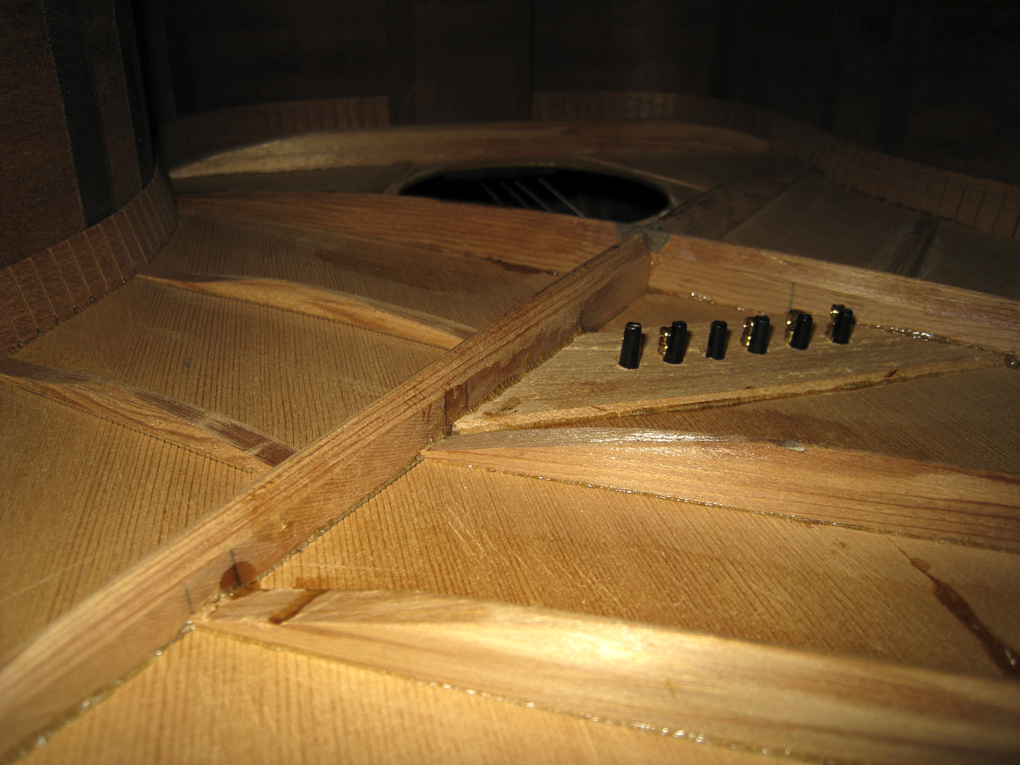
Tapered Martin Braces in 1946, which are much rounder than in 1945.
1946 000-18
In mid-1939 Martin shifted the position of the intersection of the X on 000 size guitars and Dreadnaughts from roughly one inch below the edge of the soundhole to roughly 1 3/4" back, in a move known as "Forward X" or "High X" to "Rear X" bracing, to make the top more stable. Some players prefer the sound of the earlier version, which makes these guitars highly sought after, while some believe the later version is easier to "mic".
The position of the braces on 14 fret 00 Martins changed in 1935. 12 fret Martins did not change.
In roughly 1958, the bracing of Dreadnaughts changed again, from back shifted X to slightly less backshifted X with a wider cross angle.
Note that in mid-1939, most Martins added a "popsicle brace" at the same time the upper transverse brace was increased from 5/16" to 1/2" in width.
These changes appear to have occurred at the same time the neck width changed from 1 3/4" to 1 11/16" and neck block on dreadnaughts changed from 1 9/16" to 1 5/16" in thickness.
1931 or 1932:
1"-wide trapezoidal to 1 3/8"-wide hexagonal bridgeplates
Mid 1935:
Forward shifted to rear shifted braces on 12 fret 00 Martins
Mid 1938:
Forward shifted to rear shifted braces on 000 and Dreadnaught Martins
Mid 1939:
1 3/4" to 1 11/16" neck
Popsicle brace added
5/16" wide to 1/2" wide upper transverse brace (UTB)
1 9/16" to 1 5/16" thick neck block on dreadnoughts, to match small bodied Martins.
1940 or 1941:
1 3/8" wide hexagonal to 1 3/8"-wide trapezoidal bridge plates
1945:
Scalloped to tapered braces
1958:
Back shifted X to slightly less back shifted X with a wider cross angle
earlymartin.com
To See Robert Corwin's Classic Photography of Folk and Roots Musicians, visit:
For Information on Photography for
Exhibition, Publication, CD's, Promotion, Web Pages, Tour Books,
to Purchase Photographic Prints, or
If You Have Questions About An Early Martin Guitar:
e-mail: Robert Corwinentire site copyright ©1998 through 2013 Robert Corwin/Photo-Arts. All rights reserved.
